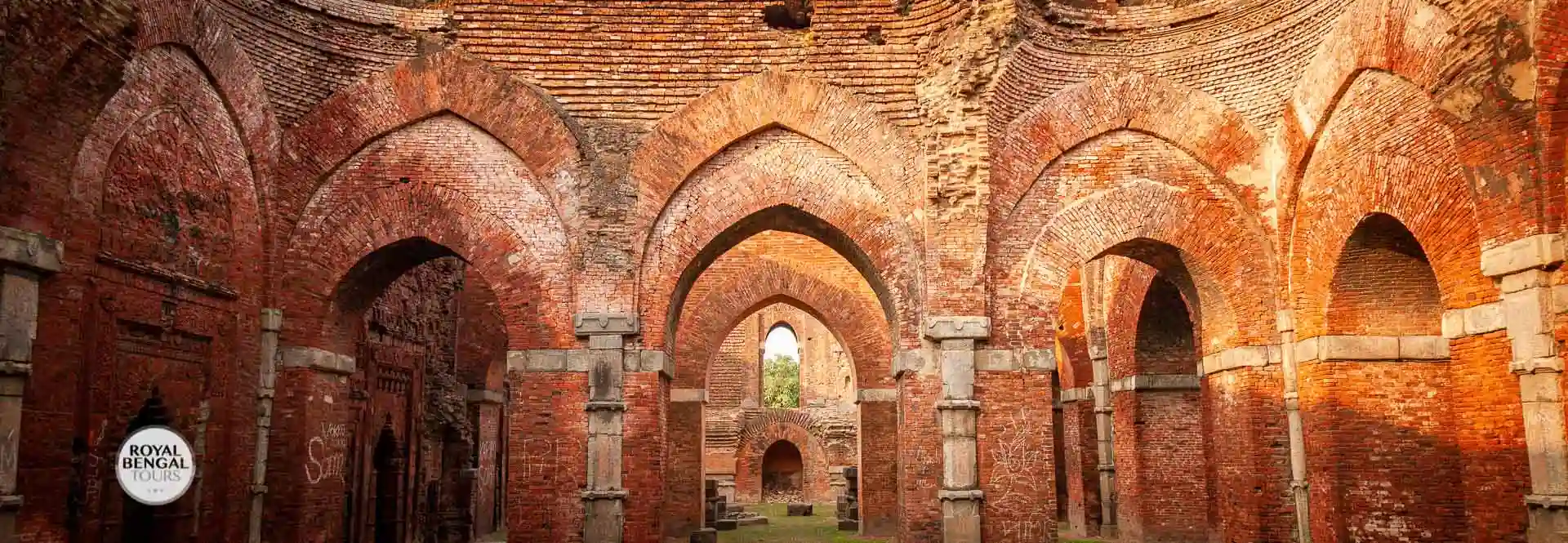The capital of the Sena dynasty in the north-western Bengal
Gaur
Gaur or Gaud or Gauda was the ancient capital established by Hindu Senas and called Lakhnauti, which has turned into a site of great historical importance. Gaur has more mosques than any area of the country after Dhaka and Bagerhaat. It is located about 100 km west of Rajshahi City, on Bangladesh - India border, under Chapainawabgonj district. Archaeological heritage and artefacts of this area are Chhota Sona Mosque, Darashbari Mosque and Madrasa (1479), Dhanichak Mosque, Dakhil Darwaza, Khanjan Dighi Mosque, Kachari Bari of Shah Suja (Tahakhana), Tohakhana Mosque, Tomb of Shah Niamatullah, but none of the structures from the earlier Hindu Kingdoms remains.
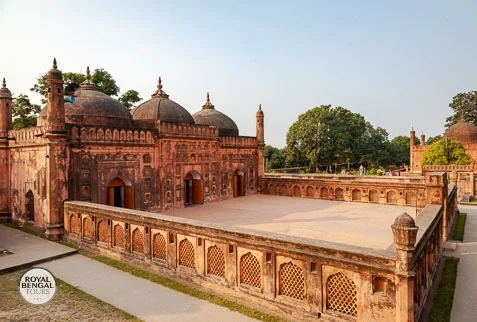
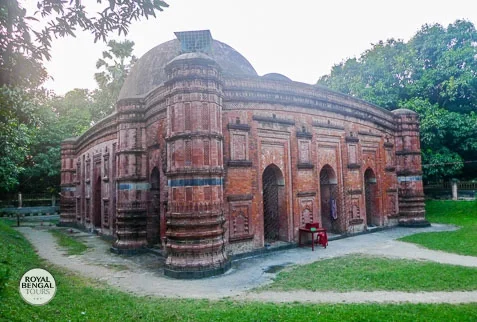
The Bengal Delta’s fertile agriculture made it possible for socially stratified and economically diversified societies to develop from early times. Archaeological studies show that urban centers came up as early as the 15th century BCE. Through the following centuries, large towns would grow along major rivers rather than on the exposed sea coast. The fortunes of these cities were connected to the whims of the deltaic rivers: whenever a river moved its course, and the port silted up, the town would sink. Tamralipti was an early victim, one of India’s largest ports and possibly ‘ the main trade emporium of the wide area between Alexandria and China. Famous for a thousand years, its fortunes reversed in the eighth century CE as the delta expanded southwards and its port silted up. Today it is a land-bound district town known as Tamluk.
Gaur or Gauda
Gaur or Lakhnauti demonstrates the vicissitudes of riverside urbanisation. It is not known when this busy port in the northwestern delta at the junction of three channels of the Ganges was established, but it clearly went through many cycles of development and decay. In the twelfth century CE, it was the capital of the Sena dynasty, and the Moroccan traveller Ibn Battuta visited it 150 years later. In the fifteenth century, it was one of the largest cities in South Asia. In 1521 a Portuguese visitor found that the streets were broad and straight and yet so thronged with traffic and people that it was difficult to move. The houses - were one-storied, had courtyards and gardens. Many had walls and floors covered with ornamental blue and gold tiles that may have been Chinese imports. The city is thought to have had a population of 200,000 (although one estimate at the time put it at 1.2 million).
Like all riverside cities in the history of Bangladesh, Gaur felt the power of the river to give prosperity or to take it away. During its heyday (the early 1200s to 1575), Gaur was settled and abandoned several times, depending on the Ganges moving westwards and back again. When the river moved away, it was not only an economic disaster (even though feeder canals were made, ships could no longer reach the port) but also a health disaster, as swamps formed and malaria and other fevers broke out. In 1575 a severe epidemic sounded the death – knell for Gaur: the river had moved away once more, and this time a combination of political instability and problems in trade with Southeast Asia sealed its fate. Today, the river flows about fifteen kilometers from Gaur’s ruins, which stretch over an area of thirty by six kilometers and include monumental gates, fortifications, palaces, mosques, bridges, causeways, canals, loading platforms and underground sewers. Part of the ruins lies in Bangladesh and part across the border in India.
The rise and fall of Gaur were just one episode in the delta’s long history of flexible urbanization. As the rivers and the villages of deltaic Bengal, centers of urban power and commerce have always been remarkably mobile, and so have their inhabitants and the trade routes they served. The same holds for the political organizations and states ruling the delta.
Small Golden Mosque
Chhota Sona Mosque
The small Golden Mosque is a living one because of daily use by the neighbours. Located about half a kilometre southeast of the Tahkhana complex, the gem of Sultanate architecture is standing by the main road and on the southern bank of a large water tank of Gaur-Lakhnauti. This is very well preserved and an impressive example of pre-Mughal architecture.
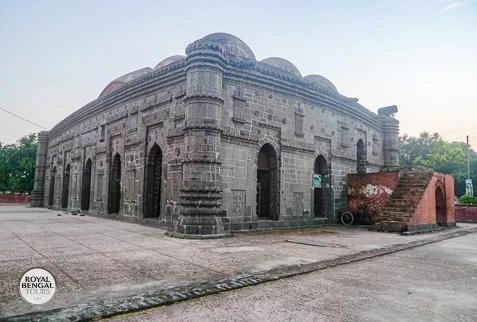

It derived its name from the fact the original roofing with fifteen gilded domes, including Chau-Chala (Bengal- Hut-Style) domes in the middle row. The inscription found on the front wall indicates that the Mosque was built by Majlis Mansur Wali Muhammad bin Ali sometime between this period 1493 -1519 AD.
The rectangle shape mosque is made from bricks and stones. This elegant monument has a gently curved cornice characteristic of the era and has stone channels to drain out the rainwater from the roof. All four external walls and, to some extent, internal walls are covered with granite stone blocks. The Mosque originally was surrounded by 42m (East to west) and 43m (North to south), an outer wall with a gateway in the middle of the eastern side. Except for the gateway, the entire surrounding wall has disappeared, but it can be traced from the remains.
There is an ornate’ Ladies Gallery’ or Badshah-ka-takht carried on finally carved slender stone columns in the northwest corner of the Mosque.
The superb decoration is the main attraction of this monument. Carved in shallow relief on both the outer and inner surface of all walls, the elaborate stonework seems like a faithful replication of the extremely developed typical terracotta arts of Bengal, and it is the similar appearance that is found in its wood- carvings or filigree work. The inner floor of the Mosque was originally covered with decorative shiny tiles with floral patterns.
On the southeast corner of the mosque premise is two modern graves of the then Heroic East Pakistan Military Soldiers Major Nazmul Hoque Tulu (d 27 September 1971) and Captain Mohiuddin Jahangir (d 14 December 1971), who died near Chapai Nawabganj Town during the Bangladesh liberation war in 1971, fighting against the Pakistani Army.
The Tahkhana Complex
Tahkhana or Shah Nimatullah Hammam
Persian word Tahkhana literally stands for a cooler house or palace. Tahkhana is also known as the Hammam or underground chambers of the Saint Shah Nimat Ullah in Firozpur village of Gaur - Lakhnauti, near the mosque and tomb of supreme spiritual leader Shah Nimat-Ullah. This two-storey brick building measures 35m from north to south and 11.58m from east to west. It has been a temporary residence and built by the Governor of Bengal Shah Shuja himself, who often visited his spiritual advisor, the saint Shah Nimat-Ullah.

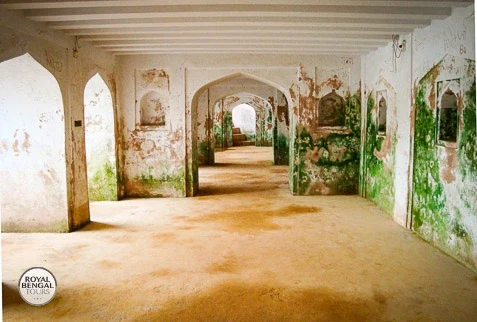
This is known as ‘Tahkhana’ because its ground floor is built into the western bank of a large pond at the water level, while the upper floor is level with the surrounding ground surface of the tomb and mosque. There are numbers of cells on the ground floor. The upper floor contains seventeen apartments, including two octagonal chambers in the southeast and northeast corner. There are the remains of an ornamental fountain in one of the chambers on the northeastern corner. The main suite leads into a 4m wide roofed verandah, with five archway openings on the west, and on its eastern side, there is a greatly dilapidated open terrace that partially overlies the flat roof of the ground floor.
This is the only flat roof of the Mughal’s time in Gaur that used timber beams overlaid with surkhe (mixture of limestone, bricks powder/chips and rotten brown sugar) concrete slabs. A domed hammam is located on the southern part of the building, with a stairway in the southeast corner that leads downwards to the water edge. Earthen water pipelines are buried inside of the Hammam walls for the cold and hot water supply to both the toilet complex to the south and the Hammam.
The Hamman of Shah Niamatullah or Tahkhana as a whole is much significant because of their architectural character, first introduced in Bengal, and they became the prototype of subsequent constructions – be that a tomb, a mosque or a palace in the subsequent Mughal capitals in Murshidabad or Dhaka.
The Mosque and Tomb of Shah Nimatullah
The Mosque and the mausoleum of Shah Nimatullah are adjacent at the north of the Tahkhana or Hammam building, constructed by Shah Shuja for his spiritual advisor, who was once honoured as a guest at Shah Shuja's Rajmahal.

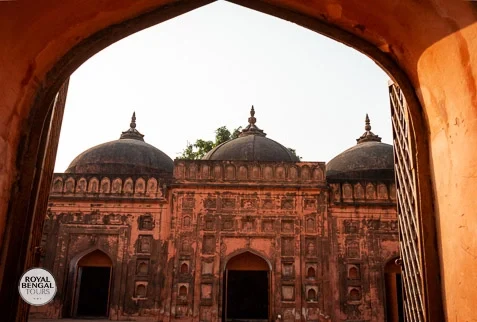
The oblong-shaped Shah Nimatullah Mosque is typical Mughal style three-domed and measures 19.38m from north to south and 7.58m from east to west. The central dome is extended slightly forward, and the facade is divided into three bays. Blind merlons characterise the arches niches with the hanging chain and bell motif inside and on the cornice.
The Tomb of Shah Nimatullah is a single dome and low square structure measuring 15m with three equally aligned entrances on each side. The 17th-century tomb was built Shah Shuja to honour his spiritual guide. The grave of Shah Nimatullah is at the tomb’s central chamber, surrounded by a vaulted verandah with dome ceilings at the corners.
A lotus-shaped finial of elegant design crowns the dome and the four small turrets on the corners. Probably this was the first living tomb in Bengal to present the influence of imperial Mughal mausoleums.
The surviving mihrab decoration in ruins
Darasbari Mosque
Darasbari is the most prominent remains of a Mosque in the Bangladesh part of Gaur. The Mosque is standing at a desolated area near the Indian border in the Darasbari quarter of the mediaeval city on the western side of the Nawabgonj - Rajshahi highway. The word Darasbari means 'home of learning.' pointing at a madrasa (Typical Islamic School) to the east of the Mosque cross the enormous tank. According to its inscription, which is now preserved at a Museum in Calcutta, Shamsuddin Abul Muzaffar Yusuf Shah has founded this Mosque in 1479 AD.
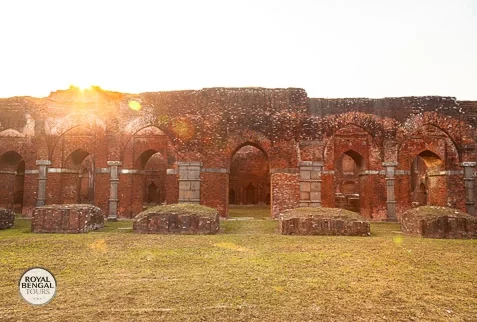
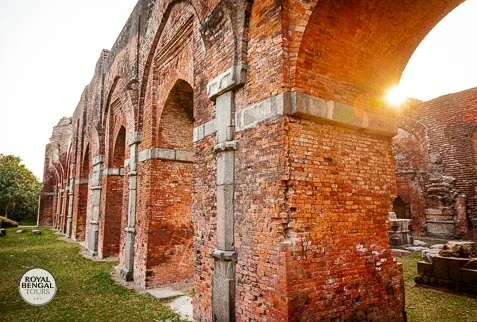
This structure is a good presentation of the mature architecture of the IIyas Shahi era. The oblong prayer hall is attached with a verandah on the east. The prayer chamber entered through the seven arched doorways of the verandah, probably have been covered with a sequence of domes, including a chain of chau-chala or dome-shaped roof in the central row, but all of those have fallen apart. Probably there was a ‘Royal Gallery or Ladies Gallery’, in the northwest corner built as an upper storey, which was accessible from outside through a stairway.
The ornamentation of this Mosque was the most luxurious character. The western interior wall of the prayer room was dipped with nine mihrabs which represent some superb geometric and terracotta ornamentation of various floral patterns in bold relief. One particular design, which describes a striking foliage pattern representing a parasitic creeper, is worth mentioning. The vine is rooted into the bole of a palm tree and spreads itself out to completely cover the space with its foliage. This motif strangely finds a close parallel to a decorative motif in the famous Sidi Sayyid Mosque in distant Ahmadabad, which was built at about the same period.
The Darasbari Mosque at its prime time must have been one of the most spectacular specimens of Sultanate mosques style in Gaur-Lakhnauti. Together with other contemporary examples, this Mosque has earned and spread the ‘Gauriya’ style’ all over Bengal and created its identity as the Independent Bengal Style of the mediaeval era.
The Islamic School
Darasbari Madrasah
It was a significant discovery of Darasbari Madrasa. Located on the west of Nawabgonj – Rajshahi highway, about half a kilometre east of Darasbari Mosque, across the water tank in the neighbouring Ghoshpur village. This is a unique architectural example for a Madrasa from the medieval period and demonstrates the development of the dormitory-style through the earlier Buddhist monasteries discovered in Mainamati, Bogra, Paharpur and elsewhere in Bangladesh. According to the inscription, it was constructed in 1504 AD by Alauddin Husain Shah.
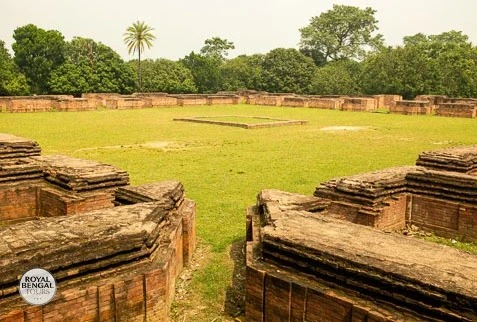
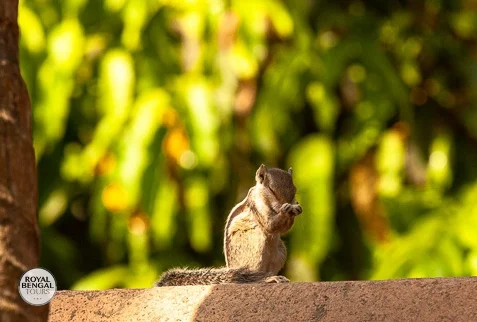
A huge selection of terracotta plaques found during excavation (1973-75). It is a 52m square-shaped madrasah foundation, comprising of 40 cells (3sqm each) distributed through four wings around a 37m square inner courtyard, which has been recently exposed. Three large gateways have been located in the middle of the north, south and east wings, and there are three Mihrabs in the western wing. There were towers in each of the four corners, and each of the three gateways, as well as the prayer hall had additional projecting towers. The centre of the courtyard appeared to be a covered rectangular shed that had octagonal towers at each corner. The exact purpose of this pavilion is not known yet, but it could be a lecture hall-cum-library or a large ornate pool with a spouting jet inside.
Khania Dighi or Rajbibi Mosque
Beautiful Khania Dighi mosque is also known as Rajbibi Mosque, is located on the western bank of Khania Dighi (Water Tank) and inside of a huge mango garden in Chapara village, Gaud. The reason is unknown why it was named after Rajbibi; surely, she was an influential woman of the royal harem. This brick made single domed square prayer chamber affix a 9m verandah in the east. The verandah is with three smaller squat domes, while the main prayer chamber is roofed by a large semi-circular dome.
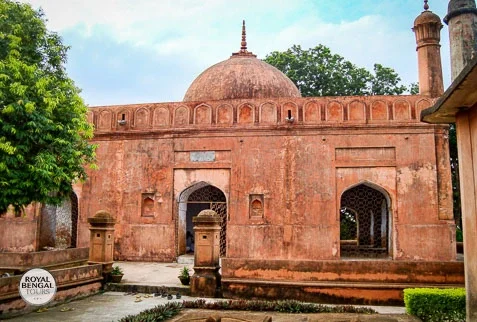

The Mosque is dated back from 1490 from the architectural points of view, and an inscription with Quranic verses still exists on the front wall. The cornices of the Mosque are slightly curved, and all the towers are divided into segments by raised bands. Three highly ornate black stone semi-circular mihrab on the qibla (western) wall, placed corresponding to three eastern archways. The wall surfaces are ornately decorated also sparsely relieved with stone carvings; here, they are richly embellished primarily with terracotta floral designs. A number of black basal pillars are holding the dome of the main prayer chamber.
Dhanichak Mosque
The remains of the Dhunichak Mosque is located to the south of the enclosed city of Gaur. Only the north and west wall remain upright, with only the foundations left of the south and east walls. The mosque derived its name from cotton carders (Dhanchak), hence Dhanchak or Dhunichak masjid. Stylistically the mosque dated to the later Ilyas Shahi period though no inscription has been found to validate its origin. Probably it was covered by a single dome which must have collapsed a long time ago.
This mosque, with a rectangular sanctuary measuring 13m (north-south) and 9m (east-west) with 1.7m thick walls. Three mihrabs on the western wall are richly ornamented with floral and geometric patterns, the central one being prominent. The spandrels over the cusped arches are beautifully decorated with terracotta tree motifs, intertwining prominent terracotta rosettes within its branches. The rectangular frames enclosing each mihrab are boldly relieved with creeper motifs and bands of mouldings. The interior was divided by black basalt pillars into two aisles of three bays, each corresponding to the three entrance archways. The western wall has carved brick forms distributed with exquisitely carved stone pilasters of Hindu artistry.


